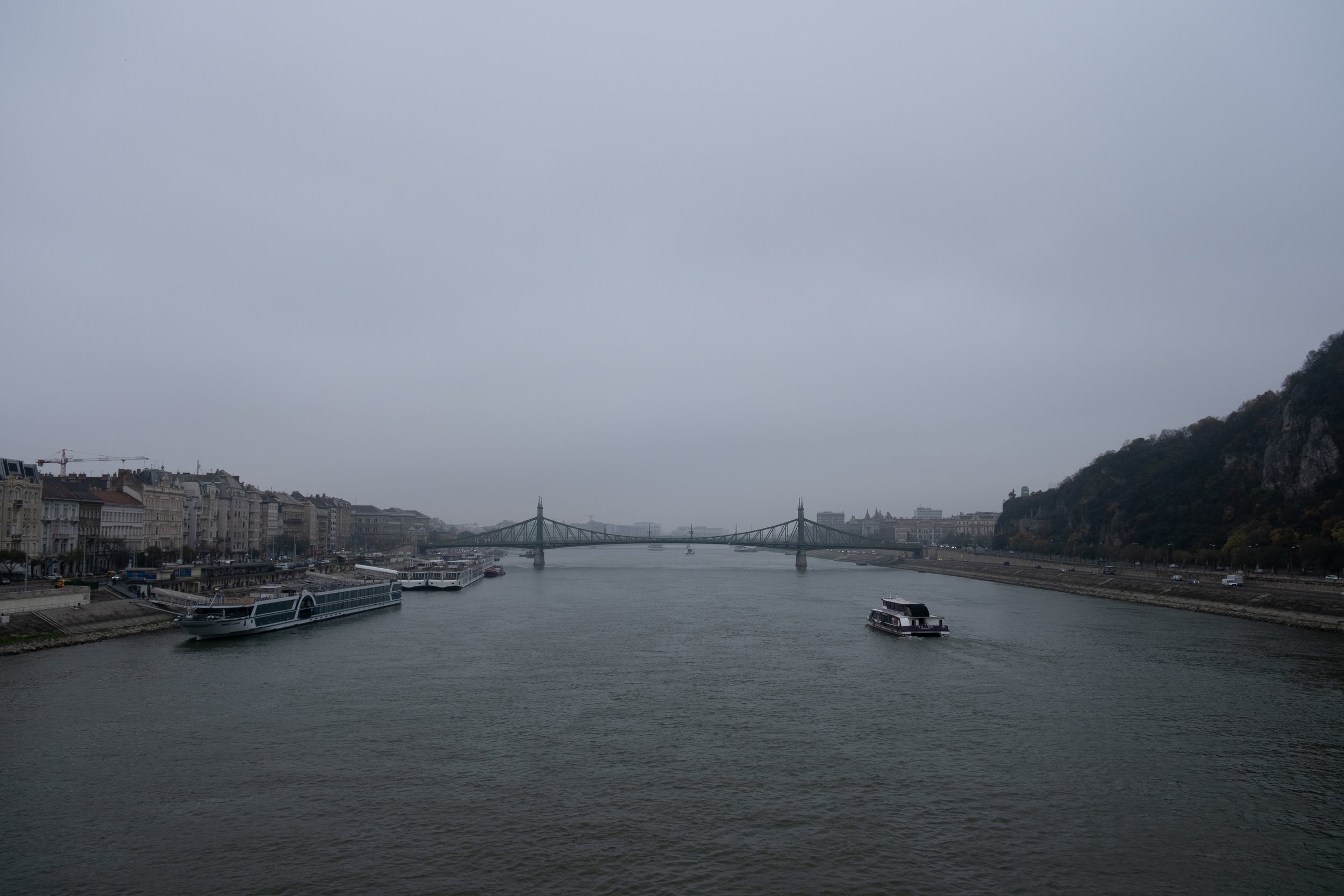Budapest
I’ve seen many grey cities – Berlin, London, Vienna, Tokyo – but Budapest feels like one of the greyest. Perhaps my perspective is skewed by my arrival in early November, on a long bus ride from Krakow over winding hilly roads, crossing the border into Hungary through a light fog.
I say Budapest is grey, and in the gloomy shade of autumn it certainly felt it – but I don’t mean that as a pejorative in the slightest. I am, after all, from one of the greyest places on earth; I love grey. And Budapest is certainly a rich shade of grey.
I entered the city from a bus station on the southeastern side, and then walked for what, with my heavy pack, felt like an endlessly self-replenishing row of blocks to get to my airbnb. Like so many European apartments, the building looked like some communist afterthought mouldered by time, and probably not up to fire code; yet the actual flat was spotless and new.
The next morning I set out across the city. Budapest is a compound city: the ancient capital was actually Buda, on the fortified hills on the western side of the Danube, while Pest is a much broader and flatter sprawl – but the towns have grown together like commingled trees, to the point even the names have merged.
Not a block from my flat I was surprised to see a mural depicting a saintly refugee mother and admonishing support for the displaced. I am embarrassed to say I was surprised, as I have caught myself stereotyping, which I usually warn against. In America in recent years, in certain very online political circles, Hungary has become flattened into a sort of avatar of a certain type of nationalist right-wing politics. While these certainly do dominate the country’s government, it was helpful to start with a humbling reminder that countries are large and complex and contain multitudes.
Proceeding west toward the river (for I was staying in Pest), I passed the Dohany Street Synagogue, the largest such house of worship in Europe, and then passed on down a street bustling with cars and lined with buildings that ranged from modern minimalism through to art nouveau.
Then I was crossing the Danube, the biggest river I had yet seen in Europe, pea-green under the cloudy sky. This is the legendary waterway that so often marked the northern frontier of Rome, that links ex-Habsburg capitals with the Balkans and empties into the Black Sea, and from there flows past Constantinople and Gibraltar before it can join the great world-ocean.
On the west bank of the river I passed a famous chapel hewn from living rock, a statue of St. Stephen (not the Martyr but Hungary’s first king), and then proceeded up a forested hill decorated with lovely mansions, including the home of the heroic Swedish diplomat Raoul Wallenberg, who saved thousands of Jews from the Nazis only to be disappeared by the Red Army at the end of the war, dying at an unknown time in Soviet custody. Above this neighborhood towers a Hungarian statue of liberty, holding aloft a branch, and from the muddy trails around it, the river unrolls toward north and south until it vanishes in the mist.
From there I walked north toward another hill, the old citadel of Buda, with its blocky castle (which is now being expanded and reconstructed as a sort of nationalist project). Atop this hill sits one of the great churches of Budapest, the Matthias Church, so named for the 15th century king Matthias Corvinus, with its beautiful roof and soaring bell-tower.
Behind the church is the Fisherman’s Bastion, a cone-roofed balustrade which overlooks the city, complete with another inevitable statue of Stephen.
Inside, the church is a heaven of vaults, glowing with light, and throughout are scattered treasures of silver and gold and glass, including what I think is a replica of the Holy Crown of Hungary, complete with bent cross (or possibly the original – I’ve read contradictory things), and a statue of Austrian Empress Sisi, beloved in Hungary for her advocacy of the Hungarian side of the Austro-Hungarian Empire.
The citadel outside the church is a series of narrow lanes lined with colorful old buildings, from which I descended by many stairs through the gathering dusk, to glimpse the stunning neo-Gothic spikes of the Magyar Parliament just across the river.
The next day a little blue sky broke through the clouds, so I could see again the red in the remaining leaves, and I returned to the citadel to spend a few hours acquainting myself with Hungarian artists I had never heard of, like the wonderful Mihály Munkácsy.
I then wandered my way around the north side of town, through a sort of mall, past decaying pink facades, over the great yellow bridge on the Danube, and past Hungarian Parliament, as the light faded into desaturated lilacs and periwinkles.
South of Parliament, I came across an amusing juxtaposition: in the same square stands Ronald Reagan, a liberatory figure to Hungarians under Soviet domination. He smiles, hand outstretched, toward another monument only a few yards in front of him: a Soviet monument to their army’s liberatory moment against the Nazis. Now they stand nextdoor in a strange new world.
On this last evening in Budapest, I decided to stop into St. Stephen’s Basilica, and I’m glad I did: the Basilica is a vast universe of gold and red marble, and a dome painted with a depiction of God. But the most interesting and strange thing I found was the Holy Right Hand of King St. Stephen. Tradition says it is the mummified hand of the founding king, one thousand years old. Whether or not this is true, it is certainly a person’s hand in a glass box, and you don’t see that every day.



























































